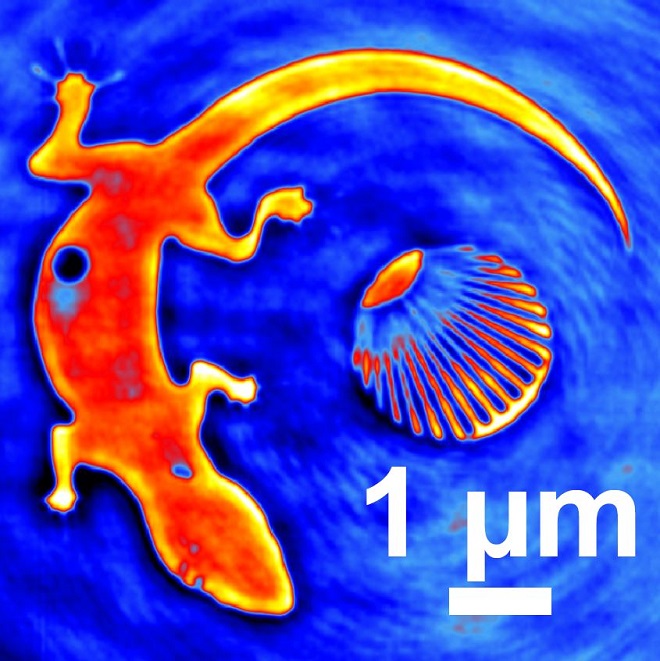January 07, 2014
A team headed by Stefan Eisebitt has developed a new X-ray holography method that will enable snap-shots of dynamic processes at highest spatial resolution. The efficiency of the new method is based on a X-ray focussing optics being firmly fixed to the object to be imaged. While this approach initially provides a blurry image, this can be focussed in the computer based on the hologram information. At the same time, the rigid connection between the object and the focussing optics elegantly solves the problem of vibration induced jitter that plays an enormous role at the nanometre scale.
Prof. Stefan Eisebitt, who heads the division Nanometre and X-Ray Optics at Technische Universität Berlin and the joint research group Functional Nanostructures at Helmholtz-Zentrum Berlin (HZB), explains: “Just as a fast objective lens on a camera enables you to get a sharp image even under conditions of weak lighting, our optical element here enables the X-ray light to be used more efficiently as well. At the same time, we have firmly coupled this X-ray lens with the object to be imaged so that vibrations no longer have any detrimental influence and the image is stabilised.” As a consequence, low-contrast or moving nanoobjects can be imaged notably better.
For X-ray holography, you need coherent light – light whose electromagnetic waves oscillate synchronously. This is the kind of light produced by lasers or by synchrotron sources like BESSY II. In the holographic process used here, part of the X-ray light falls on the object and part of it carries on through a pinhole aperture placed laterally beside the object to create the reference wave. A hologram is formed by superposing the two waves and recording the result with a detector. A holographic image of the illuminated object is then reconstructed on a computer. However, the pinhole aperture approach has a disadvantage. In order to produce a sharp image, the aperture must be very small, which therefore transmits too little light to create a good image from low-contrast objects or during short exposure times – a dilemma.
Optical element increases brightness
Physicists working with Eisebitt found a solution by using an optical element known as a Fresnel zone plate. This is placed in the plane of the object itself as a substitute for the pinhole aperture and considerably increases the brightness of the reference wave. However, the focal point of this optical element is not in the plane of the object (as the pinhole aperture would be), so that the image is out of focus. In contrast to photography, however, this blur in the image can be precisely corrected for via the information stored in the hologram. Due to the efficiency of the method, exposure times can be significantly reduced, allowing the study of fast dynamic processes.
Test objects to measure the resolution
Ph.D. student Jan Geilhufe worked out this idea and implemented it. He was also the one who introduced the image of a lizard as a filigreed test object. Its outline was reduced by a factor of 10,000 and transferred onto gold foil. “It was important to us to find a test object with some originality for demonstrating how well the method works”, says Geilhufe. The seashell in the centre of the test object displays a section of what is called a Siemens star, a test pattern used to determine spatial resolution. Similar to how the converging rays of a Siemens star can be used to measure how well narrow lines will be reproduced in an image, you can also use the lizard’s tail. With a diameter of six thousandths of a millimetre, the entire test object is about the size of a red blood cell. The smallest resolved structure has a width of no more than 46 nanometres.
X-ray camera with an image stabiliser
The well-known problem of jitter due to vibrations of the object in relation to the optics becomes increasingly dramatic at higher resolution of an optical system. “In current research for high-resolution X-ray imaging, a resolution of less than ten nanometres is the target. That distance is tiny - less than a chain of one hundred single atoms. For that reason, even the smallest fluctuations are noticeable. A streetcar passing by a kilometre away can be a disturbance”, says Geilhufe. “In our process, we have firmly coupled the object to the reference optics so that the lens fluctuates exactly synchronized with the object. We have built an X-ray camera with an image stabiliser, so to speak.”
Eisebitt emphasizes: “The combination of the world-renowned expertise in manufacturing Fresnel zone plates at HZB, together with the structuring flexibility afforded by the “Nano-Workbench” at TU Berlin, has made this progress possible.”
New method will be implemented at BESSY II as part of the RICXS instrument
The work is being published today in Nature Communications. The improvement in imaging efficiency and resulting possibilities for improvement in spatial and temporal resolution promises new insights into dynamic nanoscale processes, such as fastest magnetic switching in data storage. “We hope that our approach is useful for many areas of research and contributes to understanding the world at the nanometre scale”, says Eisebitt. He and his team are looking forward to offering their new holographic technique to researchers from all over the world at BESSY II as part of the RICXS instrument.
The paper is published in Nature Communications (DOI: 10.1038/ncomms4008).















